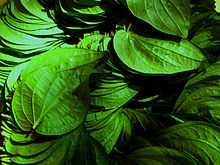
The areca nut is the fruit of the areca palm, which grows in much of the tropical Pacific, South Asia, Southeast Asia, and parts of east Africa. It is commonly referred to as betel nut, not to be confused with betel leaves that are often used to wrap it. Consumption has many harmful effects on health and is carcinogenic to humans. Various compounds present in the nut, including arecoline, contribute to histologic changes in the oral mucosa. It is known to be a major risk factor for cancers of the mouth and esophagus. As with chewing tobacco, its use is discouraged by preventive efforts. Consumption by hundreds of millions of people worldwide – mainly of South Asian or Southeast Asian origins – has been described as a "neglected global public health emergency".

Gutka, ghutka, guṭkha or betel quid is a chewing tobacco preparation made of crushed areca nut, tobacco, catechu, paraffin wax, slaked lime and sweet or savory flavourings, in India, Pakistan, other Asian countries, and North America.

The betel, Piper betle, is a species of flowering plant in the pepper family Piperaceae, native to Southeast Asia. It is an evergreen, dioecious vine, with glossy heart-shaped leaves and white catkins. Betel plants are cultivated for their leaves which are most commonly used as flavoring in chewing areca nut.

Betel nut chewing, also called betel quid chewing or areca nut chewing, is a practice in which areca nuts are chewed together with slaked lime and betel leaves for their stimulant and narcotic effects. The practice is widespread in Southeast Asia, Micronesia, Island Melanesia, and South Asia. It is also found among the indigenous peoples of Taiwan, Madagascar, and parts of southern China. It has also been introduced to the Caribbean in colonial times.
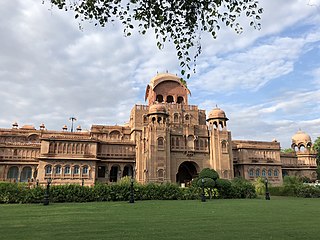
Bikaner is a city in the northwest of the state of Rajasthan, India. It is located 330 kilometres (205 mi) northwest of the state capital, Jaipur. Bikaner city is the administrative headquarters of Bikaner District and Bikaner division.

Muzaffarpur is a city located in Muzaffarpur district in the Tirhut region of the Indian state of Bihar. It serves as the headquarters of the Tirhut division, the Muzaffarpur district and the Muzaffarpur Railway District. It is the fourth most populous city in Bihar.

Mysore State, colloquially Old Mysore, was a state within the Dominion of India and the subsequent Republic of India from 1947 until 1956. The state was formed by renaming the Kingdom of Mysore, and Bangalore replaced Mysore as the state's capital. When Parliament passed the States Reorganisation Act in 1956, Mysore State was considerably enlarged when it became a linguistically homogeneous Kannada-speaking state within the Republic of India by incorporating territories from Andhra, Bombay, Coorg, Hyderabad, and Madras States, as well as other petty fiefdoms. It was subsequently renamed Karnataka in 1973.

Areca catechu is a species of palm which grows in much of the tropical Pacific, Asia, and parts of east Africa. The palm is believed to have originated in the Philippines, but is widespread in cultivation and is considered naturalized in southern China, Taiwan, India, Bangladesh, the Maldives, Sri Lanka, Cambodia, Laos, Thailand, Vietnam, Malaysia, Indonesia, New Guinea, many of the islands in the Pacific Ocean, and also in the West Indies.
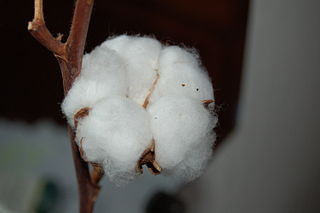
Ranebennuru is a city in Haveri district in Karnataka, India.It is situated 300 kilometres (190 mi) northwest of Bengaluru, the capital of Karnataka. Other nearby cities include Hubballi (108 km) and Mangaluru (271 km).
The Office of the Controller General of Patents, Designs and Trade Marks(CGPDTM) generally known as the Indian Patent Office, is an agency under the Department for Promotion of Industry and Internal Trade which administers the Indian law of Patents, Designs and Trade Marks.

Bidriware is a metal handicraft from the city of Bidar in southern India. It was developed in the 14th century C.E. during the rule of the Bahmani Sultans. The term "bidriware" originates from the township of Bidar, which is still the chief center of production. The metal used is white brass that is blackened and inlaid with silver. This native art form has obtained Geographical Indications (GI) registry.

Warli painting is a form of tribal art mostly created by the tribal people from the North Sahyadri Range in Maharashtra, India. This range encompasses cities such as Dahanu, Talasari, Jawhar, Palghar, Mokhada, and Vikramgad of Palghar district. This tribal art was originated in Maharashtra, where it is still practiced today.

Banganapalle mangoes is a mango variety produced in Banganapalle of Nandyal District in the Indian state of Andhra Pradesh. It alone occupies 70% percent of total mango cultivable area of the state and was first introduced by the Farmers of Banaganapalli. It was registered as one of the geographical indication from Andhra Pradesh on 3 May 2017, under horticultural products by Geographical Indication Registry. It is also grown in the other parts of India and Pakistan. The fruit is described as obliquely oval in shape, around 20cm in length, with yellow flesh and a thin, smooth yellow skin. The flesh is of a firm, meaty texture and is sweet and lacks fibre. The cultivar is the most sought after in Andhra Pradesh. It is a very late -season variety that is good for canning. This cultivar is a source of vitamin A & C and is also called king of Mangoes.
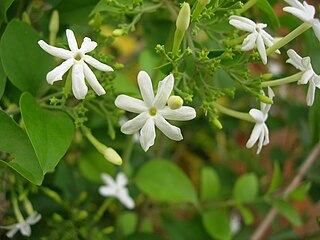
Jasmine is considered the queen of flowers and is called the "Belle of India" or the "Queen of fragrance" as it is exquisitely scented to soothe and refresh. In different parts of India it is called by different names—Mogra, Motia, Chameli, Malli puvvu, Jaati, Mulla, Mallige, Juhi, Mogra or Moonlight in the grove. It is reported that there are 300 varieties of jasmine. It is also stated that jasmine crossed the seas—from Asia to Europe, landing first along the Mediterranean Sea, conquering Greece and Turkey, reaching Western Europe through Spain, then France and Italy and finally landing in England in the latter part of the 17th century..

Patachitra or Pattachitra is a general term for traditional, cloth-based scroll painting, based in the eastern Indian states of Odisha, West Bengal and parts of Bangladesh. Patachitra artform is known for its intricate details as well as mythological narratives and folktales inscribed in it. Pattachitra is one of the ancient artworks of Odisha, originally created for ritual use and as souvenirs for pilgrims to Puri, as well as other temples in Odisha. Patachitras are a component of an ancient Bengali narrative art, originally serving as a visual device during the performance of a song.

Mysore Agarbathi is a variety of incense sticks manufactured at Mysore using locally grown ingredients which was found only in state of Karnataka before. This incense has been awarded Geographical Indication tag from the Government of India in 2005 due to its historic background and remote availability of material used. Aptly, Mysore is also home to the world's largest manufacturer of agarbathi - N. Ranga Rao & Sons popularly known for the Cycle Pure Agarbathies.
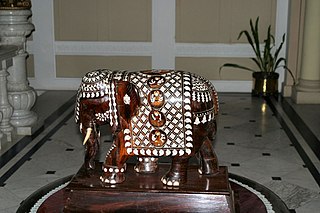
Mysore Rosewood Inlay covers a range of techniques used by artisans in around the area of Mysore in sculpture and the decorative for inserting pieces of contrasting, often coloured materials like ivory shells, mother-of-pearl, horn and sandalwood into depressions in a rosewood object to form ornament or pictures that normally are flush with the matrix. These artifacts are manufactured in around the region of Mysore, these artifacts have been awarded Geographical Indication tag from the Government of India in 2005 due to its historic representation as an artifact depicting the region and the design and style used by the local artisans

The Nanjangud banana, natively called as Nanjangud rasabalehannu, is a variety of banana grown in and around the area Mysore district and Chamarajanagar district of Karnataka, India. It is famous for its unique taste and aroma. It was found that the black clay alluvial saline soil found in and around Nanjangud drastically changed the taste and aroma, giving it a particular geographical identity, so it is now registered under geographical indicators under Government of India.

Habaspuri is a cotton-based traditional handloom textiles of Odisha, India. Habaspuri sari is a major product of this textile. The Bhulia weavers of Chicheguda, Kalahandi district, Odisha are originally attributed for weaving of the Habaspuri fabric. For its uniqueness in weaving, design and production, it has been identified as one of the 14 Geographical Indications of Odisha. The textile has traditional patterns of the region like kumbha (temple), fish and flowers.

A paan dan is a container for storing paan used in South Asian households. It also stores other ingredients such as zarda, supari, kattha, choona, clove, cardamom (elachi), and other accessories. A paan dan is silverware used mostly to store betel leaf, betel seeds and most other spices for making a paan. A paan dan is often made of perforated metal and has several compartments for storing the individual ingredients for making paan.
